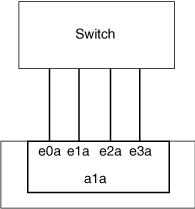Characteristics of static multimode interface groups
The static multimode interface group implementation in ONTAP complies with IEEE 802.3ad (static). Any switch that supports aggregates, but does not have control packet exchange for configuring an aggregate, can be used with static multimode interface groups.
Static multimode interface groups do not comply with IEEE 802.3ad (dynamic), also known as Link Aggregation Control Protocol (LACP). LACP is equivalent to Port Aggregation Protocol (PAgP), the proprietary link aggregation protocol from Cisco.
The following are characteristics of a static multimode interface group:
All interfaces in the interface group are active and share a single MAC address.
Multiple individual connections are distributed among the interfaces in the interface group.
Each connection or session uses one interface within the interface group.
When you use the sequential load balancing scheme, all sessions are distributed across available links on a packet-by-packet basis, and are not bound to a particular interface from the interface group.
Static multimode interface groups can recover from a failure of up to
n-1
interfaces, where n is the total number of interfaces that form the interface group.If a port fails or is unplugged, the traffic that was traversing the failed link is automatically redistributed to one of the remaining interfaces.
Static multimode interface groups can detect a loss of link, but they cannot detect a loss of connectivity to the client or switch misconfigurations that might impact connectivity and performance.
A static multimode interface group requires a switch that supports link aggregation over multiple switch ports.
The switch is configured so that all ports to which links of an interface group are connected are part of a single logical port. Some switches might not support link aggregation of ports configured for jumbo frames. For more information, see your switch vendor's documentation.
Several load balancing options are available to distribute traffic among the interfaces of a static multimode interface group.
The following figure is an example of a static multimode interface group. Interfaces e0a, e1a, e2a, and e3a are part of the a1a multimode interface group. All four interfaces in the a1a multimode interface group are active.

Several technologies exist that enable traffic in a single aggregated link to be distributed across multiple physical switches. The technologies used to enable this capability vary among networking products. Static multimode interface groups in ONTAP conform to the IEEE 802.3 standards. If a particular multiple switch link aggregation technology is said to interoperate with or conform to the IEEE 802.3 standards, it should operate with ONTAP.
The IEEE 802.3 standard states that the transmitting device in an aggregated link determines the physical interface for transmission. Therefore, ONTAP is only responsible for distributing outbound traffic, and cannot control how inbound frames arrive. If you want to manage or control the transmission of inbound traffic on an aggregated link, that transmission must be modified on the directly connected network device.